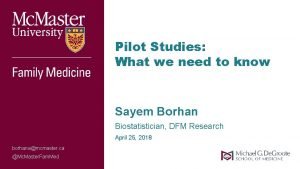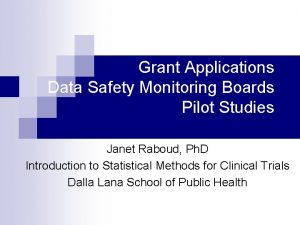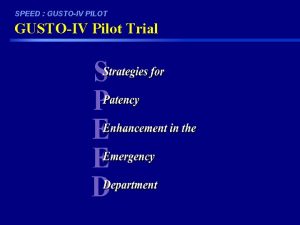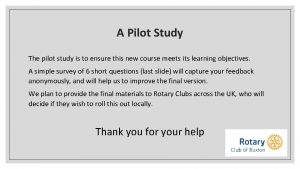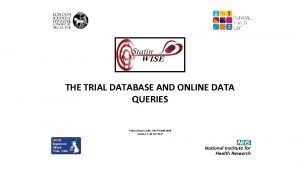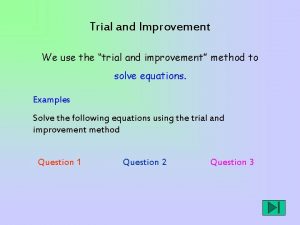The Comquol Study A pilot trial looking at


































- Slides: 34

The Comquol Study: A pilot trial looking at a structured communication intervention in secure mental health settings: Outcomes and Challenges

The research was funded by the National Institute for Health Research (NIHR) under its Research for Patient Benefit (Rf. PB) Programme (Grant Reference Number PB-PG-0609 -19107) The views expressed are those of the authors and not necessarily those of the NHS, the NIHR or the Department of Health

Research Team ✘ Professor Douglas Mac. Innes, Canterbury Christ Church University ✘ Dr Catherine Kinane, Kent and Medway Partnership Trust ✘ Dr Janet Parrott, Oxleas NHS Foundation Trust ✘ Professor Tom Craig, Institute of Psychiatry, Kings College, London ✘ Professor Sandra Eldridge, Queen Mary University, London ✘ Mr George Harrison, Oxleas NHS Foundation Trust ✘ Dr Ian Marsh, Canterbury Christ Church University ✘ Miss Jacqueline Mansfield, Canterbury Christ Church University ✘ Professor Stefan Priebe, Queen Mary University, London

Learning Objective ✘To understand the practicalities in undertaking a pilot trial in forensic settings ✘To be aware of using a computer aided structured communication approach to help collaborative decision making ✘To examine the findings for the Com. Quol study

Com. Quol Overview ✘ A pilot trial of a structured communication approach in medium secure settings (Priebe et al, 2002) ✘ Intervention comprised of six 1: 1 sessions facilitated by primary nurses ✘ The intervention consisted of two elements: ✗ A computer-mediated approach (DIALOG+) and ✗ Non-directive counselling based on SFT ✘ It employed a user centred approach promoting service users active participation in the intervention

Aims and Objectives ✘To examine the proposed methodology and establish the feasibility of the research design for a full scale trial ✘To determine the variability of the outcomes of interest ✘To estimate the cost of the proposed intervention ✘Refine the intervention following the outcome of the study based upon the experiences of the participants

Method Design ✗ 36 -Month pragmatic cluster randomised pilot trial ✗ Six medium secure units Data Collection ✘ For all quantitative data ✘ Three time points ✗ Baseline ✗ Six Months ✗ Twelve Months

Preparation and Support ✘Each nurse was individually trained to use the DIALOG+ software ✘Nurses received a three-day training in Solution Focused Brief Therapy ✘Monthly meetings were held between researcher-nurse

Activity If you were the PI of your unit, how would you consider the following: 1. How would you recruit participants (nurses and in-patients) into a study? 2. Tackling randomisation 3. Training; How could a three-day training program be organised for nurses within a medium secure setting? 4. How would you maintain the fidelity of the intervention? 5. How do you ensure the outcomes being recorded are valid and not influenced by the researcher/clinical team? 6. How would you maintain participant confidentiality? 7. Any other practical issues to consider?

Outcomes ✘Primary outcome: ✘ Quality of Life (MANSA, Priebe et al, 1999) ✘Secondary outcomes ✗ Disturbance (disturbance monitoring form) ✗ Therapeutic Relationships (HAS, Priebe & Gruyters, 1993) ✗ Ward Climate (Essen. CES, Schlast et al, 2008) ✗ User Satisfaction (FSS, Mac. Innes et al, 2010) ✗ Recovery (QPR, Neil et al, 2009) ✗ Nurse Stress (MBI, Maslach et al, 1996) ✗ Health economic data (self developed form)

DIALOG + ✘A computer-mediated intervention developed to rate a patient’s level of satisfaction and needs for care on 8 life domains and 3 treatment aspects within the routine 1: 1 session with their primary nurse ✘Provided a structure and patient-centred meeting focused on change

✘Rated on a 1 (totally dissatisfied) to 7 (totally satisfied) Likert scale across these domains • Mental health • Physical health • Accommodation • Job situation • Leisure activities • Friendships • Medication • Personal safety • Relationship with family • Practical help & friends • Consultations ✘Patient’s view on their situation and needs are the central point of discussion; their views are explicit



Activity Practice undertaking an initial assessment using the DIALOG+ software ✘Work in pairs or a small group (2 -4) ✘Rate all the domains (ensure to answer the question “Do you need additional help? ” ✘Select one of the domains, and enter a couple ‘Next Steps’

Training ✘ Three day training programme offered to all nurses in the intervention group – ensure DIALOG+ approach was consistently administered. A. Each nurse was individually trained to use the software B. Solution Focused Brief Therapy training delivered by an experienced solution-focused therapist ✘ Each nurse also received a practical handbook explaining how to conduct the solution focused approach ✘ After first training day, nurses encouraged to complete their 1 st session before the Day 2 of training ✘ Nurses brought their notes and thoughts from the initial sessions to the 2 nd and 3 rd training days for review by the SFBT trainer.

Ensuring Consistancy ✘Fidelity of the intervention assessed through a number of procedures ✘ Nurse facilitating session recorded the main topic(s) on a record sheet ✘ Up to two sessions, out of the six session, were audio recorded. ✘ The record sheets and recordings were reviewed ✘ Monthly meetings held between the Research Assistant and each nurse to examine the intervention

Solution Focused Brief Therapy ✘Counselling approach ✘Structured conversational approach that promotes movement towards positive change in individuals, families, and other systems ✘Characterised by a focus on the future, more specifically, exploring what will be different when things are better

Solution Focus vs. Problem Focus ✘Solution Focus is very different to a problem focus ✘When you are problem focused you start with a problem (you engage in problem-solving) ✘You try to find out as much as possible about the problem and its component parts ✘You try to find out ‘what’s wrong’ and fix it ✘Most medical and psychological approaches are problem focused.

✘Humans are very good at problem-solving – the problemsolving process is very effective and we are taught it from an early age. ✘Although some people might argue that solution focus is actually ‘creative problem-solving’ in order to utilise it effectively it is helpful to see it as a different type of strategy from what we normally think about as ‘problemsolving’. Solution focus is more similar to puzzle-solving strategies.

Solution Focuses On: ✘What difference a person wants to see in their life – their ‘preferred future’. ✘What is working or going well right now ✘Finding out strengths and resources in the person and their wider context ✘Working out what small steps will bring about changes towards that desired difference

Activity Working with Complaints ✘Sometimes when people are meeting with you they feel the need to complain ✘The listener generally wants to either avoid getting involved or to get stuck in to solving the problem ✘Instead SFT sees everything as an opportunity to learn about something that can help to build a solution

Activity – Moan ✘ People in pairs – A & B A = moaner B = listener ✘ Instruction for A: You have to moan to B about something that really annoys you. You have to keep moaning for 3 minutes, don’t stop, just keep going ✘ Instruction for B: You have to listen to A without saying anything. You may only nod your head. As you are listening to A think about what qualities and strengths A has simply from listening to them moaning. ✘ Ask yourself, what sort of person would complain about this thing? ✘ For example, if someone is moaning about there never being enough tills open at the supermarket, the person has probably got good organisational skills ✘ At the end of the 3 minutes B formulates some compliments for A based on what they have heard and delivers these to A.

Nurses’ Experiences ✘Overall experience positive ✘Arranging Sessions ✘Working with Intervention ✗ Software (DIALOG+) ✗ Solution Focused Therapy ✗ Helpfulness of sessions

Focus Group Themes ✘Service User Involvement ✗ Nature & benefits ✘Relationship between quality of life and perceptions of: ✗ Fairness ✗ Safety ✗ Order ✗ Humanity ✗ Trust ‘We have to see them 24/7; we have to see them every day. We have to work with them and sometimes we are polite to them and they are not polite to us. Sometimes’.

Quality of Life Scores Domain Mean (range 1 -7) (SD) Baseline 6 -Months 12 -Months Control (N = 52) 4. 2 (0. 2) 4. 3 (0. 1) 4. 3 (0. 3) Intervention (N = 53) 4. 4 (0. 3) 4. 5 (0. 4) 4. 7 (0. 2)

Treatment Effect Quality of Life Scores Treatment Effect (intervention – control) and Confidence Interval ICC (CI) 6 -Month 12 -Month 0. 2 (-0. 4 to 0. 8) 0. 4 (-0. 3 to 1. 1) 0. 04 (0. 00 to 0. 17) 0. 05 (0. 00 to 0. 18)




Resource use and costs Intervention group Control group £ 30, 413 £ 0 £ 529 - 576 £ 0 Av no of days in the facility over 12 months, mean (SD) 341 (56) 338 (37) Av cost of stay in the facility (bed-day cost) over 12 months £ 166, 064 £ 164, 506 £ 23, 697 - £ 38, 354 £ 51, 222 - £ 92, 340 £ 456 - £ 738 £ 985 - £ 1, 776 £ 167, 049 - £ 167, 378 £ 165, 491 - 166, 282 Total cost of intervention Cost of intervention per user including nurse training Total cost of incidents Cost of incidents per user Av treatment cost (intervention + stay + incidents)

Conclusions A. B. Establish the feasibility of the trial design as the basis for determining the viability of a large full-scale trial • The trial design appears viable. • The procedures seem to function well. • The response rates were good with low service user withdrawal rates. Determine the variability of the outcomes of interest • The variability of the outcomes of interest was all within normal limits. • The estimated treatment effect of the primary outcome is within the range where it could be considered significant. • A full trial would be justified to estimate the effect with greater certainty.

Conclusions C. Estimate the costs of the intervention D. Refine the intervention following the outcome of the study based upon the experiences of the participants • Incidents are costly, as associated with significant use of NHS resources and police. • Real cost of incidents may be even higher when analysed using patientlevel data. • Responses suggest general satisfaction with the approach. • Number of nurses lost to follow up questions including nursing outcomes. • The reasons for higher dropout rates for women and whether to offer ongoing support. • Examining the incident costs for longer may give a better indication of ongoing costs.

Thank You! If anyone would like further information, please contact douglas. macinnes@canterbury. ac. uk
 Impressions examples
Impressions examples Looking out looking in chapter 9
Looking out looking in chapter 9 Pilot study adalah
Pilot study adalah Commercial pilot oral study guide
Commercial pilot oral study guide Pilot study
Pilot study Sayem borhan
Sayem borhan Pilot study example
Pilot study example Hình ảnh bộ gõ cơ thể búng tay
Hình ảnh bộ gõ cơ thể búng tay Lp html
Lp html Bổ thể
Bổ thể Tỉ lệ cơ thể trẻ em
Tỉ lệ cơ thể trẻ em Gấu đi như thế nào
Gấu đi như thế nào Glasgow thang điểm
Glasgow thang điểm Alleluia hat len nguoi oi
Alleluia hat len nguoi oi Kể tên các môn thể thao
Kể tên các môn thể thao Thế nào là hệ số cao nhất
Thế nào là hệ số cao nhất Các châu lục và đại dương trên thế giới
Các châu lục và đại dương trên thế giới Công của trọng lực
Công của trọng lực Trời xanh đây là của chúng ta thể thơ
Trời xanh đây là của chúng ta thể thơ Mật thư anh em như thể tay chân
Mật thư anh em như thể tay chân Làm thế nào để 102-1=99
Làm thế nào để 102-1=99 độ dài liên kết
độ dài liên kết Các châu lục và đại dương trên thế giới
Các châu lục và đại dương trên thế giới Thể thơ truyền thống
Thể thơ truyền thống Quá trình desamine hóa có thể tạo ra
Quá trình desamine hóa có thể tạo ra Một số thể thơ truyền thống
Một số thể thơ truyền thống Cái miệng xinh xinh thế chỉ nói điều hay thôi
Cái miệng xinh xinh thế chỉ nói điều hay thôi Vẽ hình chiếu vuông góc của vật thể sau
Vẽ hình chiếu vuông góc của vật thể sau Biện pháp chống mỏi cơ
Biện pháp chống mỏi cơ đặc điểm cơ thể của người tối cổ
đặc điểm cơ thể của người tối cổ Giọng cùng tên là
Giọng cùng tên là Vẽ hình chiếu đứng bằng cạnh của vật thể
Vẽ hình chiếu đứng bằng cạnh của vật thể Tia chieu sa te
Tia chieu sa te Thẻ vin
Thẻ vin đại từ thay thế
đại từ thay thế





